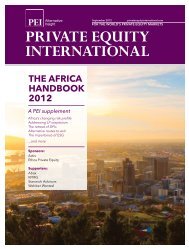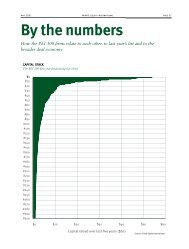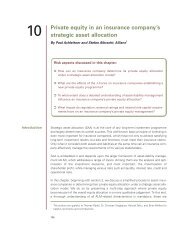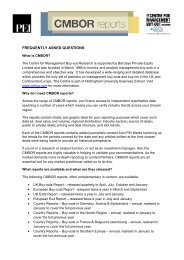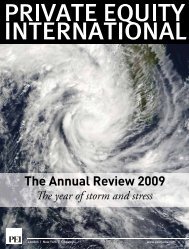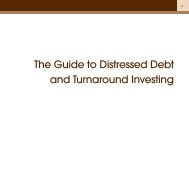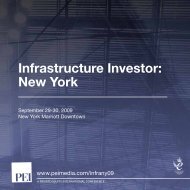Fundamentals of Private Equity and Venture Capital - PEI Media
Fundamentals of Private Equity and Venture Capital - PEI Media
Fundamentals of Private Equity and Venture Capital - PEI Media
You also want an ePaper? Increase the reach of your titles
YUMPU automatically turns print PDFs into web optimized ePapers that Google loves.
GETTING THE MOST OUT OF THIS MODULE<br />
Welcome to Module 1 in the <strong>Fundamentals</strong> <strong>of</strong> private equity series. This module<br />
introduces the core principles <strong>of</strong> private equity <strong>and</strong> venture capital, examines<br />
how they evolved <strong>and</strong> provides a broad introduction to today’s markets. It is<br />
designed to work both as a st<strong>and</strong> alone section <strong>and</strong> as part <strong>of</strong> the whole series.<br />
For the benefit <strong>of</strong> the st<strong>and</strong> alone reader, a comprehensive glossary has been<br />
incorporated, which explains the background <strong>and</strong> use <strong>of</strong> private equity terminology.<br />
All terms which may require explanation or expansion are printed in bold,<br />
to indicate that there is a glossary entry for them.<br />
<strong>Private</strong> equity – the provision <strong>of</strong> risk <strong>and</strong> reward sharing (equity) capital to a company<br />
whose shares are not freely traded on a recognised stock exchange (private).<br />
The evolution <strong>of</strong> venture capital<br />
<strong>and</strong> private equity<br />
Introduction<br />
In 1957, American Research <strong>and</strong> Development<br />
(ARD) – the world’s first ever investment<br />
fund to specialise in backing start-up companies –<br />
invested $70,000 for a 77 percent equity stake in a<br />
new company created by four students with no<br />
business experience. The company was called<br />
Digital Equipment Corporation, <strong>and</strong> 14 years later<br />
the investment’s value had grown to $355 million.<br />
Spectacular successes like this – similar stories<br />
include Apple, Intel, Sun Microsystems, Federal<br />
Express <strong>and</strong> even (in a smaller way) Trivial Pursuit<br />
– brought attention to the returns available from a<br />
new way <strong>of</strong> investing. This, for obvious reasons,<br />
acquired the tag “venture capital”.<br />
The concept <strong>of</strong> providing financial backing to<br />
entrepreneurs, sharing risks <strong>and</strong> rewards in a<br />
privately negotiated transaction, has been<br />
around since time immemorial (Queen Isobel’s<br />
backing <strong>of</strong> Christopher Columbus in the late<br />
15th Century is regularly cited as one <strong>of</strong> the first<br />
examples). More recently, the 1920s <strong>and</strong> 1930s<br />
saw companies such as Xerox <strong>and</strong> Eastern<br />
Airlines founded with private backing from<br />
wealthy family trusts. But it was the pioneer<br />
investors in the US during the 1950s, 1960s <strong>and</strong><br />
1970s who gave birth to today’s private equity<br />
industry, albeit an industry that after three<br />
decades <strong>of</strong> accelerated evolution bears little<br />
resemblance to its forebears.<br />
However the spectacular growth <strong>of</strong> private equity,<br />
from obscure specialism to economic prominence,<br />
has been far from smooth or painless. On<br />
the basis that those who fail to learn from history<br />
are condemned to repeat it – <strong>and</strong> there are parts<br />
<strong>of</strong> this story it would be better not to repeat – a<br />
brief summary <strong>of</strong> the high <strong>and</strong> low lights will<br />
bring perspective to all that follows.<br />
Evolution <strong>of</strong> the US market<br />
The early US venture capitalists were not investment<br />
managers in the conventional sense; rather<br />
they were for the most part successful entrepreneurs<br />
<strong>and</strong> corporate managers with extensive<br />
experience in building businesses. The funds<br />
they invested were to a large extent their own<br />
money. (ARD for example had, with great difficulty,<br />
raised only $1.8 million, out <strong>of</strong> a total <strong>of</strong> $5<br />
million in its first fund, from institutional<br />
investors in 1946; the balance came from the<br />
fund’s managers, individual investors <strong>and</strong> family<br />
trusts.) Their approach to investing was very<br />
proactive, becoming closely involved in the day<br />
to day running <strong>of</strong> the companies they backed, so<br />
that their expertise added at least as much value<br />
as their money.<br />
During the 1970s this began, slowly at first, to<br />
change as pension fund <strong>and</strong> insurance company<br />
fund managers noted the returns some <strong>of</strong> the<br />
venture capitalists were achieving. These institutional<br />
investors experimented cautiously with<br />
the new asset class; typically only $50 million or<br />
less was raised from these sources each year during<br />
the decade (less than 30 percent <strong>of</strong> the total,<br />
most <strong>of</strong> which came from individuals <strong>and</strong> family<br />
trusts). But suddenly <strong>and</strong> dramatically a tipping<br />
point was reached in 1980, when commitments<br />
to venture capital, during that year alone, shot up<br />
to around $1 billion, reaching nearly $2 billion in<br />
1982 <strong>and</strong> over $4 billion in 1983. 1<br />
COPYING WITHOUT PERMISSION IS UNLAWFUL<br />
THE FUNDAMENTALS OF PRIVATE EQUITY 5




